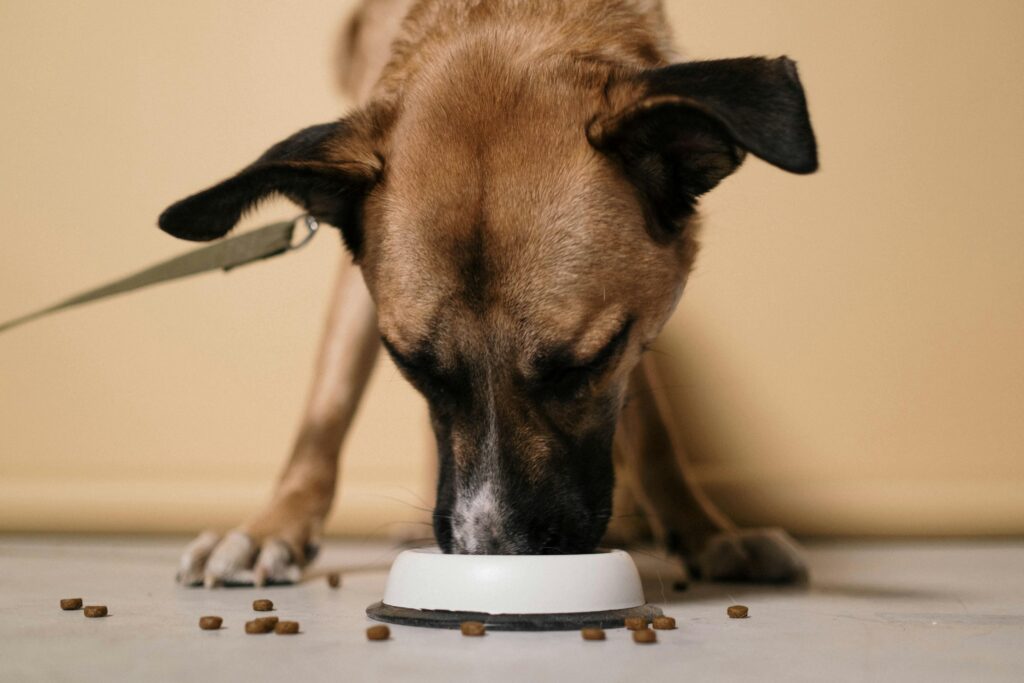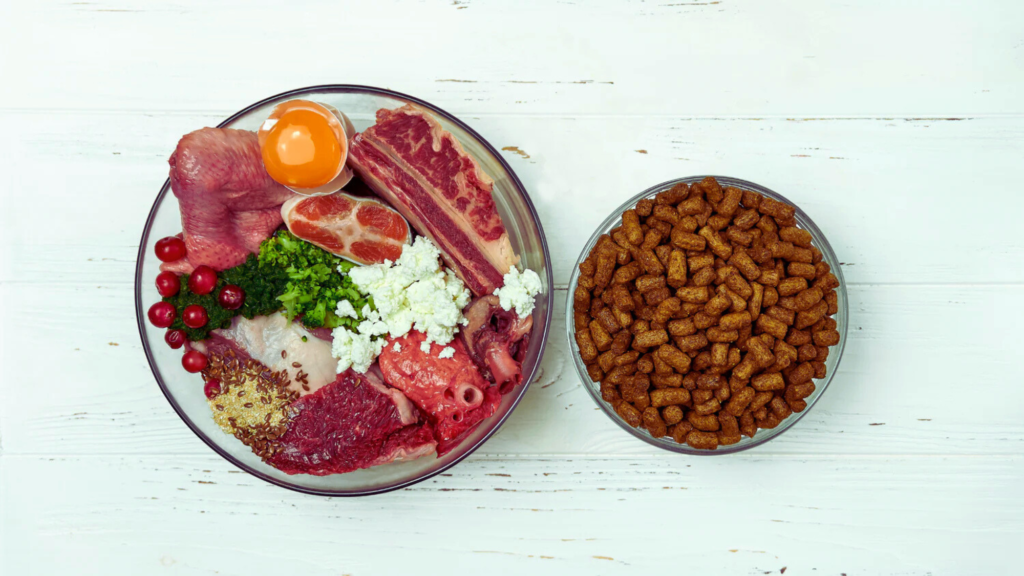| Summary: Kibble is convenient and meets AAFCO standards, but quality varies. Low-quality kibble with fillers and artificial additives can contribute to obesity, diabetes, and inflammation. High-quality kibble with real meat and healthy fats is a better choice. Supplementing with fresh foods can enhance nutrition and overall health. |
Kibble is one of the most popular dog food choices worldwide, with the pet food industry valued at $142 billion in 2023. Despite its popularity, many dog owners have started questioning whether kibble is the best choice for their pets. The rise of raw and home-cooked diets has fueled debates over the nutritional quality, health risks, and long-term effects of feeding kibble. But is kibble really bad for dogs, or does it still serve as a safe and balanced option?
Let’s dive into the science, nutritional facts, and expert opinions to uncover the truth. The recommended size collar for an English Cocker Spaniel usually ranges from 12 to 18 inches, providing a snug and comfortable fit for your dog.
Quick Fix Table
| Issue | Cause | Quick Fix |
| Obesity & Diabetes | High-carb, high-glycemic ingredients | Choose low-carb kibble with real meat protein |
| Dental Disease | Kibble residue promotes plaque | Supplement with dental chews/raw bones |
| Poor Coat & Skin | Low omega-3, high omega-6 imbalance | Add fish oil, flaxseed, or fresh fish |
| Digestive Issues | Fillers like corn, wheat, soy | Choose grain-free kibble or add fresh food |
| Artificial Additives | Preservatives, colors, BHA/BHT | Opt for kibble with natural ingredients |
Blog Highlights
ToggleWhat Is Kibble and How Is It Made?
Kibble is a dry, processed dog food made from a combination of animal proteins, grains, vegetables, fats, and added vitamins and minerals. The manufacturing process typically involves:

- Ingredient Selection – Meat, grains, and vegetables are chosen based on nutritional content.
- Grinding and Mixing – Ingredients are ground into a fine powder and blended to create a uniform mixture.
- Cooking and Extrusion – The mixture is heated at temperatures between 194°F to 284°F (90°C to 140°C) to kill bacteria and mold. It is then forced through an extruder to create kibble shapes.
- Drying and Coating – The kibble is dried to remove moisture and coated with fats and palatability enhancers.
- Packaging and Storage – The final product is bagged and stored for distribution.
While this process makes kibble convenient and shelf-stable for up to 18 months, high temperatures can destroy some of the natural nutrients in the ingredients. Manufacturers compensate for this by adding synthetic vitamins and minerals. To find the perfect fit, learn more about what size collar for a Bichon, ensuring your dog’s comfort and safety.
Nutritional Content: Is Kibble Balanced?
One of the biggest selling points of kibble is that it meets AAFCO (Association of American Feed Control Officials) standards, which means it provides complete and balanced nutrition. However, the quality of kibble can vary significantly between brands.
Protein Content
Dogs are primarily carnivores but have adapted to digest some plant-based foods. Kibble typically contains between 18% to 32% protein, but not all proteins are equal. Lower-quality kibble often uses meat by-products or plant-based proteins like soy and corn gluten meal, which are less bioavailable than real meat proteins.
A study published in The Journal of Animal Science found that high-meat protein diets improved muscle maintenance and digestion in dogs, while diets relying on plant-based proteins resulted in higher stool output and lower digestibility. High-quality kibble with real meat as the first ingredient is better than kibble loaded with fillers.
Carbohydrates: Necessary or Excessive?
Most kibble contains between 30% to 60% carbohydrates, often from grains like wheat, corn, and rice. While dogs can digest carbohydrates, they do not require them in large amounts. Excessive carbs can contribute to obesity and metabolic issues.
A study from The American Journal of Veterinary Research found that dogs fed high-carbohydrate diets had a 25% greater risk of developing insulin resistance, a condition linked to diabetes. Lower-carb kibble with more meat-based protein is generally healthier for dogs.
Fats and Omega Ratios
Fat is an essential part of a dog’s diet, providing energy and supporting coat and skin health. Most kibble contains 10% to 20% fat, but the quality and type of fat matter.
Omega-3 and omega-6 fatty acids must be balanced to prevent inflammation. Many commercial kibble brands have an omega-6 to omega-3 ratio of 20:1 or higher, whereas the ideal ratio for dogs is 5:1 or lower. High omega-6 levels, found in cheap vegetable oils like corn and soybean oil, can contribute to chronic inflammation and joint problems.
Is Kibble Really Bad For Dogs: Health Risks Associated with Kibble
So, is kibble really bad for dogs? While kibble provides balanced nutrition, several studies and reports have raised concerns about its impact on canine health.

1. Obesity and Diabetes
A 2021 study by the University of Helsinki found that dogs fed dry food had a 1.5x higher risk of obesity compared to those fed raw or fresh diets. The high carbohydrate content and added sugars in kibble contribute to weight gain, especially in inactive dogs.
Kibble also has a high glycemic index, which means it causes rapid spikes in blood sugar. Over time, these fluctuations can lead to insulin resistance and diabetes. According to the American Veterinary Medical Association (AVMA), diabetes cases in dogs have increased by 79.7% over the last decade, with diet being a major factor.
2. Dental Disease
Despite claims that kibble helps clean teeth, research suggests otherwise. A 2019 study in the Journal of Veterinary Dentistry found that 80% of dogs over three years old had some form of periodontal disease, regardless of whether they were fed kibble or wet food.

The problem is that kibble does not provide the natural chewing action needed to scrape plaque off teeth. Instead, kibble can leave starchy residues that promote bacterial growth, leading to bad breath, gum infections, and tooth loss. Raw bones and dental chews are more effective at maintaining oral hygiene. Discover the ideal option by exploring what is the best collar material for a Bichon Frise to ensure your pet’s comfort and durability.
3. Artificial Additives and Preservatives
Many commercial kibble brands contain artificial colors, flavors, and preservatives such as BHA, BHT, and ethoxyquin, which have been linked to health issues.
- BHA and BHT: Both are synthetic antioxidants used to prevent fat spoilage. Studies have linked them to liver and kidney damage in lab animals.
- Ethoxyquin: Originally developed as a pesticide, it has been associated with liver toxicity and skin allergies in dogs.
- Artificial Colors: Some kibble brands use dyes like Red 40, Yellow 5, and Blue 2, which have been linked to hyperactivity and allergic reactions.
Choosing kibble free from artificial additives is crucial for minimizing these risks.
Are There Any Benefits to Feeding Kibble?
Despite the concerns, kibble has advantages, especially for busy dog owners.
1. Convenience and Affordability
Kibble is easy to store, portion, and serve, making it a practical choice for many households. It is also more affordable than raw or fresh diets, with prices ranging from $1 to $5 per pound, depending on quality.
2. Long Shelf Life
Unlike raw food, which requires refrigeration and has a short shelf life, kibble can last for months without spoiling, making it ideal for households with multiple dogs or for travel.
3. Formulated Nutrition
High-quality kibble is formulated to meet AAFCO nutritional standards, ensuring dogs get essential vitamins, minerals, and amino acids. This is especially useful for pet owners who lack the time or knowledge to prepare a balanced homemade diet.
How to Choose a Healthier Kibble
If you decide to stick with kibble, here are some tips to choose a better option:

- Check the Ingredient List – Look for kibble with real meat (chicken, beef, fish) as the first ingredient, not meat by-products or fillers.
- Avoid Artificial Additives – Choose brands that are free from artificial preservatives, colors, and flavors.
- Look for Low Carbohydrate Content – Ideally, kibble should contain less than 30% carbohydrates to prevent weight gain and metabolic disorders.
- Check Omega-3 to Omega-6 Ratios – Opt for kibble with fish oil or flaxseed to balance essential fatty acids.
- Consider Freeze-Dried or Air-Dried Kibble – These options retain more nutrients and have fewer preservatives compared to traditional kibble.
The Role of Fresh Food in a Kibble Diet
While kibble provides convenience and affordability, it often lacks the natural enzymes and moisture found in fresh food. Many veterinarians and pet nutritionists recommend supplementing kibble with fresh, whole foods to improve overall nutrition.
This approach is called “hybrid feeding”, where kibble remains the base diet, but fresh, nutrient-dense foods are added to enhance its quality. The American Staffordshire Terrier’s coat type is short, sleek, and easy to maintain with regular brushing.
Benefits of Adding Fresh Foods to a Kibble Diet

- Improved Digestibility
Many kibble formulas contain fillers like corn, wheat, and soy, which can be difficult for dogs to digest. Adding lean meats, eggs, or lightly steamed vegetables provides more bioavailable nutrients that are easier on the digestive system. Studies show that dogs fed fresh food alongside kibble have better stool consistency and reduced gas issues. - Increased Hydration
Kibble contains only 6% to 10% moisture, while fresh meat has about 70% water content. Dogs that eat exclusively dry food often don’t get enough hydration, which can contribute to kidney disease and urinary tract infections. Adding moisture-rich foods like raw goat’s milk, bone broth, or fresh meats can help keep dogs properly hydrated. - Stronger Immune System
Fresh food is packed with natural antioxidants, vitamins, and minerals that boost immune function. Foods like blueberries (rich in vitamin C), pumpkin (high in fiber and beta-carotene), and sardines (loaded with omega-3s) provide essential nutrients that kibble alone may lack. - Better Coat and Skin Health
Many dogs on a kibble-only diet suffer from dry skin, excessive shedding, and itchiness due to a lack of essential fatty acids. Adding omega-3-rich foods like fish, flaxseed, or chia seeds can improve coat shine and reduce inflammation. - Lower Risk of Chronic Diseases
Fresh food can help counteract the high glycemic index of kibble. A study published in The Journal of Veterinary Internal Medicine found that adding fresh food to a dog’s diet can reduce the risk of metabolic disorders by 30%. Whole foods provide natural enzymes that aid digestion and support long-term health.
Conclusion: Is Kibble Really Bad for Dogs?
Kibble is not inherently bad for dogs, but its quality varies greatly. Low-quality kibble loaded with fillers, artificial preservatives, and excessive carbohydrates can contribute to obesity, diabetes, dental disease, and inflammation. However, high-quality kibble with real meat, healthy fats, and minimal additives can be a convenient and nutritionally sound option.
Ultimately, the best diet for a dog depends on its individual health needs, lifestyle, and owner preferences. If kibble is the chosen option, selecting a high-quality brand and supplementing with fresh foods like lean meats, vegetables, and omega-rich oils can help improve overall nutrition.
Hope so, now you know the answer: Is kibble really bad for dogs. The best collar size for an American Staffordshire Terrier ensures a comfortable and secure fit for your dog during walks and training.
For those looking for a better alternative, fresh, raw, or home-cooked diets may provide superior nutrition while reducing the risks associated with processed food. Regardless of the diet choice, regular veterinary check-ups and proper portion control are key to ensuring a long, healthy life for your dog.





